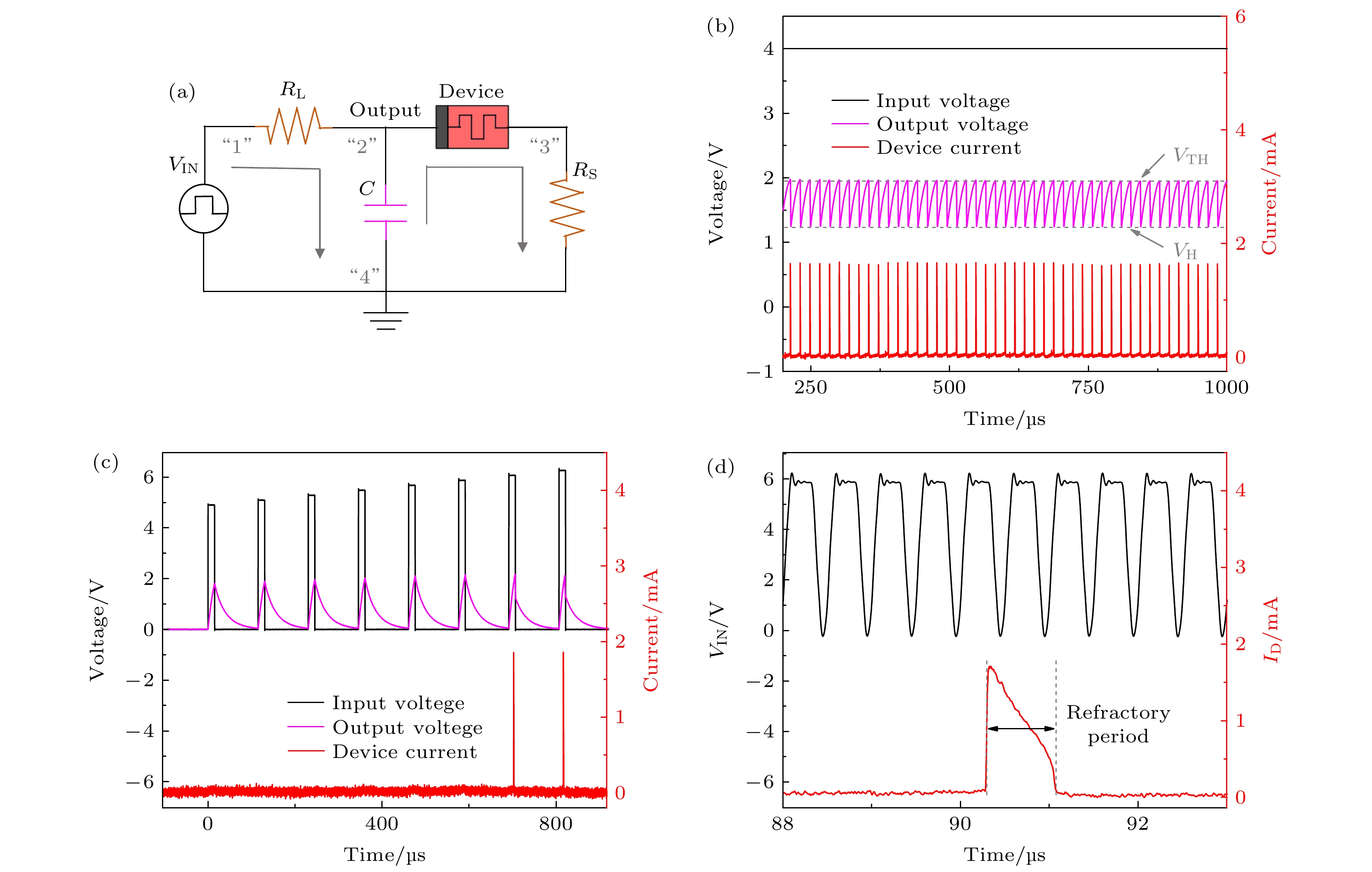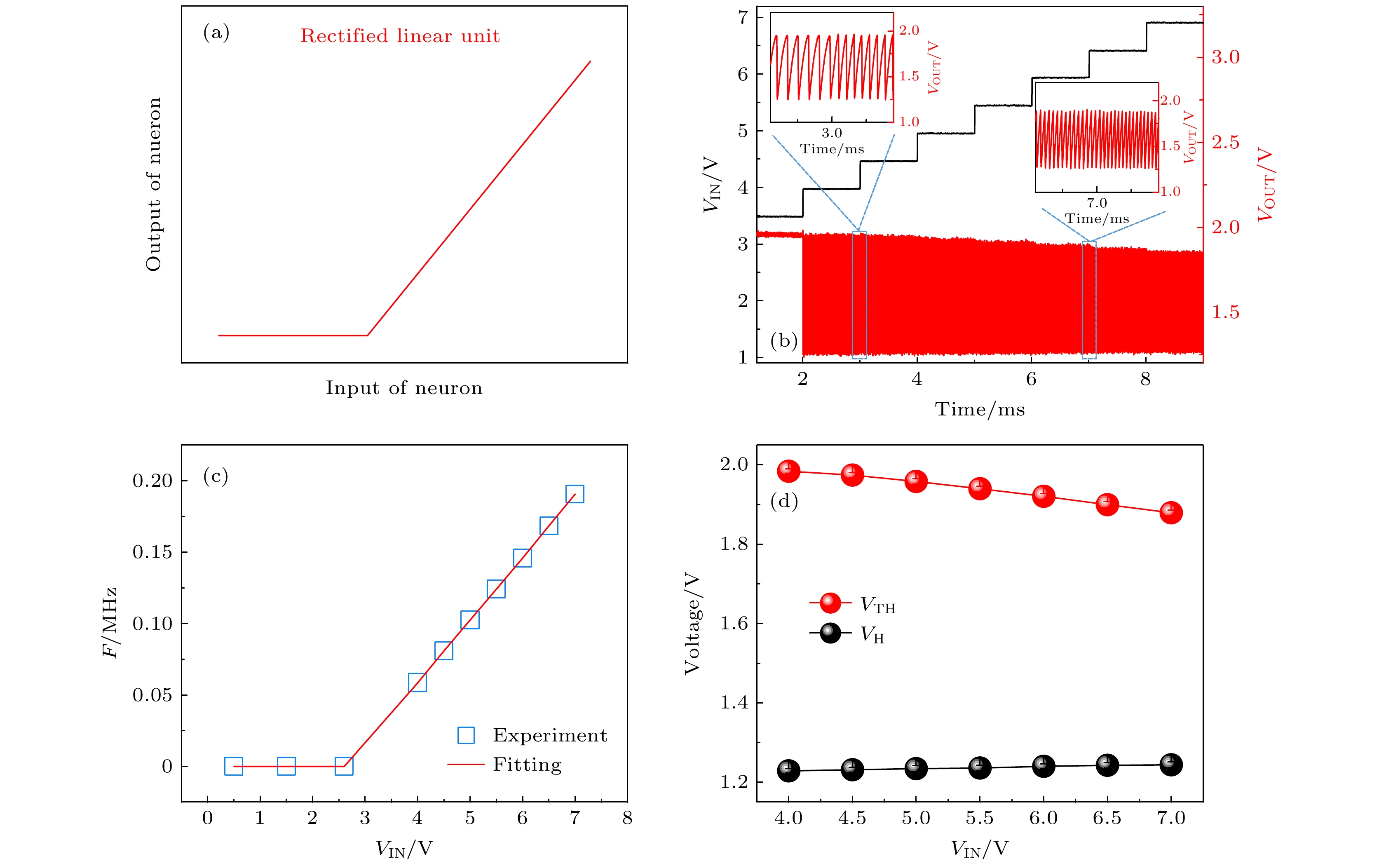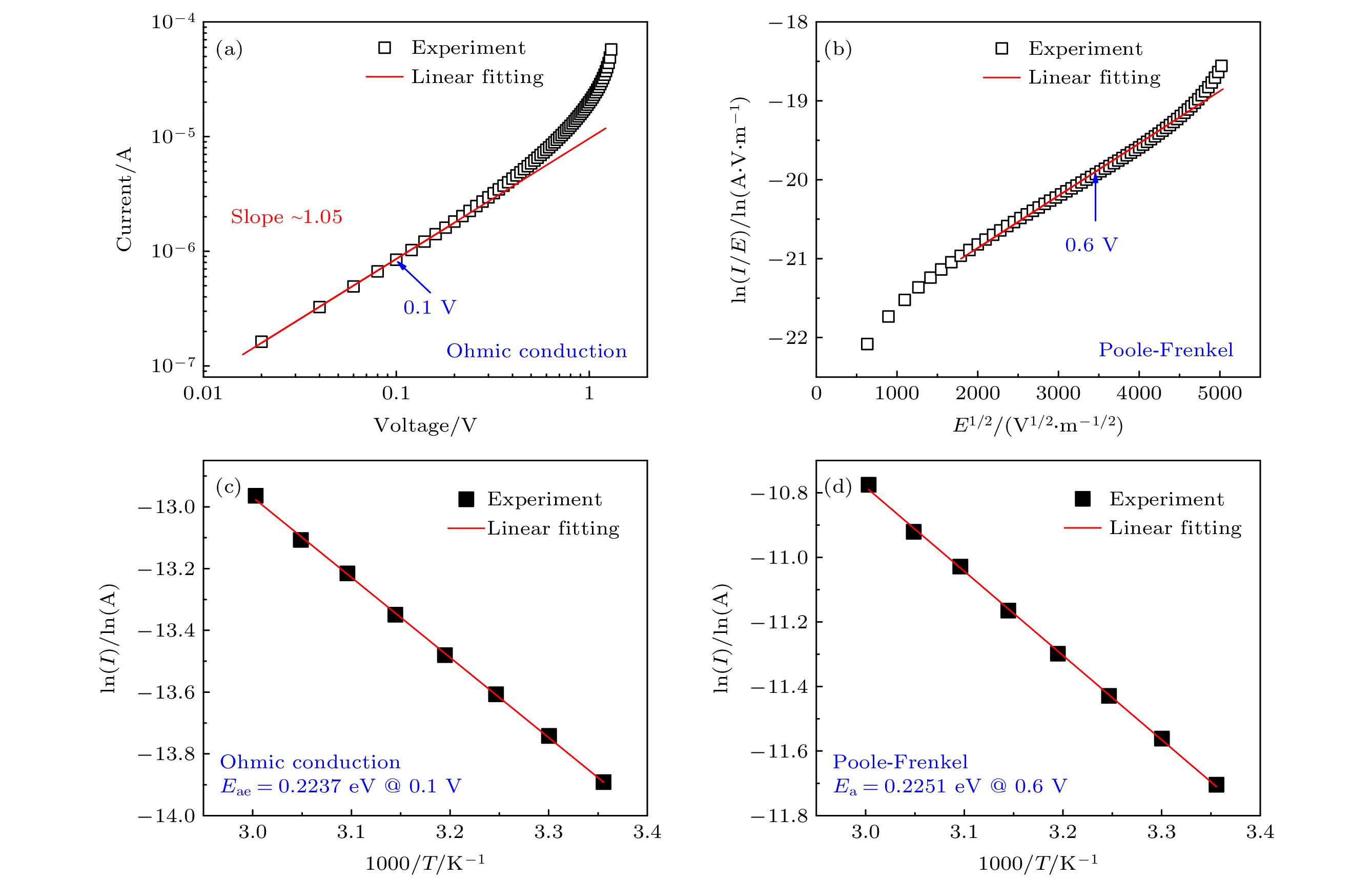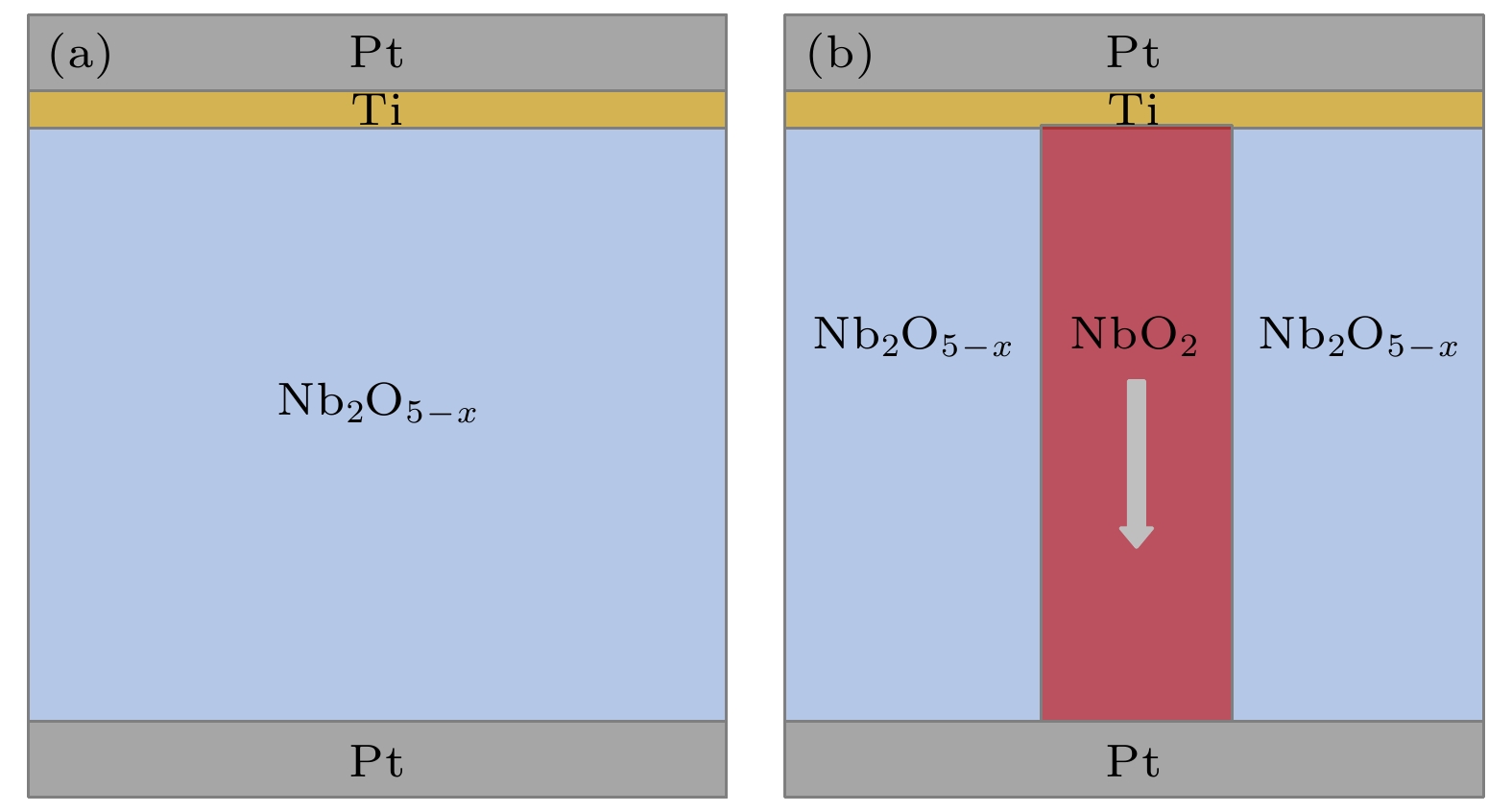-
受人脑工作模式的启发, 脉冲神经元作为人工感知系统和神经形态计算体系的基本计算单元发挥着重要作用. 然而, 基于传统互补金属氧化物半导体技术的神经元电路结构复杂, 功耗高, 且缺乏柔韧性, 不利于大规模集成和与人体兼容的柔性感知系统的应用. 本文制备的柔性忆阻器展示出了稳定的阈值转变特性和优异的机械弯折特性, 其弯折半径可达1.5 mm, 弯折次数可达104次. 基于此器件构建的神经元电路实现了神经元的关键积分放电特性, 且其频率-输入电压关系具有整流线性单元相似性, 可实现基于转换法的脉冲神经网络中神经元的非线性处理功能. 此外, 基于电子传输机制和构建的核壳模型, 对柔性忆阻器的工作机制进行分析, 提出了电场和热激发主导的阈值转变机制; 进一步对忆阻器和神经元的电学特性进行电路仿真模拟, 验证了柔性忆阻器和神经元电路工作机制的合理性. 本文对柔性神经元的研究可为神经形态感知和计算系统的构建提供硬件基础和理论指导.Inspired by the working modes of the human brain, the spiking neuron plays an important role as the basic computing unit of artificial perception systems and neuromorphic computing systems. However, the neuron circuit based on complementary metal-oxide-semiconductor technology has a complex structure, high power consumption, and limited flexibility. These features are not conducive to the large-scale integration and the application of flexible sensing systems compatible with the human body. The flexible memristor prepared in this work shows stable threshold switching characteristics and excellent mechanical bending characteristics with bending radius up to 1.5 mm and bending times up to 104. The compact neuron circuit based on this device shows the key features of the neuron, such as threshold-driven spiking, all-or-nothing, refractory period, and strength-modulated frequency response. The frequency-input voltage relationship of the neuron shows the similarity of the rectified linear unit, which can be used to simulate the function of rectified linear unit in spiking neural networks. In addition, based on the electron transport mechanism, a core-shell model is introduced to analyze the working mechanism of the flexible memristor and explain the output characteristics of the neuron. In this model, the shell region consisting of Nb2O5–x is subjected to ohmic conduction, while the core region consisting of NbO2 is dominated by Poole-Frenkel conduction. These two mechanisms, combined with Newton’s law of cooling, dominate the threshold switching behavior of flexible memristor device. Furthermore, the threshold switching characteristic of the memristor is simulated, verifying the rationality of the working mechanism of the flexible memristor. Considering the fact that the threshold voltage decreases with temperature increasing, a correction term is added to the temperature of the shell region. Subsequently, the output characteristics of the neuron regulated by the input voltage are simulated. The simulation results show that the frequency increases but the threshold voltage decreases with the input voltage increasing, which is consistent with the experimental result. The introduction of the correction term confirms the influence of the thermal accumulation effect of the flexible substrate on neuron output characteristics. Finally, we build a spiking neural network based on memristive spiking neurons to implement handwriting recognition, achieving a 95.6% recognition rate, which is comparable to the ideal result of the artificial neural network (96%). This result shows the potential application of the memristive spiking neurons in neuromorphic computing. In this paper, the study of flexible neurons can guide the design of neuromorphic sensing and computing systems.
[1] Wang Z, Wu H, Burr G W, Hwang C S, Wang K L, Xia Q, Yang J J 2020 Nat. Rev. Mater. 5 173
 Google Scholar
Google Scholar
[2] Zhou F, Chai Y 2020 Nat. Electron. 3 664
 Google Scholar
Google Scholar
[3] Pei J, Deng L, Song S, Zhao M, Zhang Y, Wu S, Wang G, Zou Z, Wu Z, He W 2019 Nature 572 106
 Google Scholar
Google Scholar
[4] Merolla P A, Arthur J V, Alvarez-Icaza R, Cassidy A S, Sawada J, Akopyan F, Jackson B L, Imam N, Guo C, Nakamura Y 2014 Science 345 668
 Google Scholar
Google Scholar
[5] Furber S B, Galluppi F, Temple S, Plana L A 2014 Proceedings of the IEEE 102 652
 Google Scholar
Google Scholar
[6] Benjamin B V, Gao P, McQuinn E, Choudhary S, Chandrasekaran A R, Bussat J M, Alvarez-Icaza R, Arthur J V, Merolla P A, Boahen K 2014 Proceedings of the IEEE 102 699
 Google Scholar
Google Scholar
[7] Davies M, Srinivasa N, Lin T H, Chinya G, Cao Y, Choday S H, Dimou G, Joshi P, Imam N, Jain S 2018 Ieee Micro 38 82
 Google Scholar
Google Scholar
[8] Ji X, Zhao X, Tan M C, Zhao R 2020 Advanced Intelligent Systems 2 1900118
 Google Scholar
Google Scholar
[9] Pan F, Gao S, Chen C, Song C, Zeng F 2014 Mater. Sci. Eng. R-Rep. 83 1
 Google Scholar
Google Scholar
[10] Raoux S, Xiong F, Wuttig M, Pop E 2014 MRS Bull. 39 703
 Google Scholar
Google Scholar
[11] Doevenspeck J, Garello K, Verhoef B, Degraeve R, van Beek S, Crotti D, Yasin F, Couet S, Jayakumar G, Papistas I 2020 2020 IEEE Symp. VLSI Technol. Honolulu, HI, USA, June 16–19, 2020 pp1–2
[12] Vorotilov K A, Sigov A 2012 Phys. Solid State 54 894
 Google Scholar
Google Scholar
[13] Rivnay J, Inal S, Salleo A, Owens R M, Berggren M, Malliaras G G 2018 Nat. Rev. Mater. 3 1
 Google Scholar
Google Scholar
[14] Shi T, Wang R, Wu Z, Sun Y, An J, Liu Q 2021 Small Struct. 2 2000109
 Google Scholar
Google Scholar
[15] Ielmini D, Wong H S P 2018 Nat. Electron. 1 333
 Google Scholar
Google Scholar
[16] Yang R, Huang H M, Guo X 2019 Adv. Electron. Mater. 5 1900287
 Google Scholar
Google Scholar
[17] Wang M, Luo Y, Wang T, Wan C, Pan L, Pan S, He K, Neo A, Chen X 2021 Adv. Mater. 33 2003014
 Google Scholar
Google Scholar
[18] Jung Y H, Park B, Kim J U, Kim T i 2019 Adv. Mater. 31 1803637
 Google Scholar
Google Scholar
[19] Yi W, Tsang K K, Lam S K, Bai X, Crowell J A, Flores E A 2018 Nat. Commun. 9 4661
 Google Scholar
Google Scholar
[20] Stoliar P, Tranchant J, Corraze B, Janod E, Besland M P, Tesler F, Rozenberg M, Cario L 2017 Adv. Funct. Mater. 27 1604740
 Google Scholar
Google Scholar
[21] Zhang X, Wang W, Liu Q, Zhao X, Wei J, Cao R, Yao Z, Zhu X, Zhang F, Lü H 2017 IEEE Electron Device Lett. 39 308
 Google Scholar
Google Scholar
[22] Zhang X, Wu Z, Lu J, Wei J, Lu J, Zhu J, Qiu J, Wang R, Lou K, Wang Y 2020 2020 IEEE IEDM San Francisco, CA, USA, December 12–18, 2020 pp29.6.1–29.6.4
[23] Zhang X, Zhuo Y, Luo Q, Wu Z, Midya R, Wang Z, Song W, Wang R, Upadhyay N K, Fang Y 2020 Nat. Commun. 11 1
 Google Scholar
Google Scholar
[24] Lashkare S, Bhat A, Kumbhare P, Ganguly U 2018 2018 NVMTS Sendai, Japan, October 22–24, 2018 pp1–4
[25] Wu Q, Dang B, Lu C, Xu G, Yang G, Wang J, Chuai X, Lu N, Geng D, Wang H 2020 Nano Lett. 20 8015
 Google Scholar
Google Scholar
[26] Zhang X, Wang Z, Song W, Midya R, Zhuo Y, Wang R, Rao M, Upadhyay N K, Xia Q, Yang J J 2019 2019 IEEE IEDM San Francisco, CA, USA, December 7–11, 2019 pp6.7.1–6.7.4
[27] Jerry M, Parihar A, Grisafe B, Raychowdhury A, Datta S 2017 2017 Symp. VLSI Technol. Kyoto, Japan, June 5–8, 2017 ppT186–T187
[28] Wang P, Khan A I, Yu S 2020 Appl. Phys. Lett. 116 162108
 Google Scholar
Google Scholar
[29] Chiu F C 2014 Adv. Mater. Sci. Eng. 2014 578168
 Google Scholar
Google Scholar
[30] Slesazeck S, Mähne H, Wylezich H, Wachowiak A, Radhakrishnan J, Ascoli A, Tetzlaff R, Mikolajick T 2015 RSC Adv. 5 102318
 Google Scholar
Google Scholar
[31] Kumar S, Wang Z, Davila N, Kumari N, Norris K J, Huang X, Strachan J P, Vine D, Kilcoyne A D, Nishi Y 2017 Nat. Commun. 8 1
 Google Scholar
Google Scholar
[32] Nandi S K, Nath S K, El-Helou A E, Li S, Ratcliff T, Uenuma M, Raad P E, Elliman R G 2020 ACS Appl. Mater. Interfaces 12 8422
 Google Scholar
Google Scholar
[33] Nath S K, Nandi S K, Li S, Elliman R G 2019 Appl. Phys. Lett. 114 062901
 Google Scholar
Google Scholar
[34] Kumar S, Williams R S 2018 Nat. Commun. 9 2030
 Google Scholar
Google Scholar
[35] Nath S K, Nandi S K, El-Helou A, Liu X, Li S, Ratcliff T, Raad P E, Elliman R G 2020 Phys. Rev. Appl. 13 064024
 Google Scholar
Google Scholar
[36] Jung K, Kim Y, Im H, Kim H, Park B 2011 J. Korean Phys. Soc 59 2778
 Google Scholar
Google Scholar
[37] Radhakrishnan J, Slesazeck S, Wylezich H, Mikolajick T, Ascoli A, Tetzlaff R 2016 CNNA 2016: 15th International Workshop on Cellular Nanoscale Networks and their Applications Dresden, Germany, August 23–25, 2016 pp1–2
-
图 2 柔性忆阻器基本电学特性 (a) 柔性PI/SiO2/Ti/Pt/NbOx/Ti/Pt忆阻器结构示意图; (b) 忆阻器基本I-V曲线; (c) 50次电学循环下阈值电压和保持电压的累积分布函数; (d) 器件差异性表征
Fig. 2. Basic electrical characteristics of flexible memristor: (a) Structure diagram of PI/SiO2/Ti/Pt/ NbOx/Ti/Pt memristor device; (b) basic current-voltage (I-V ) curve of memristor; (c) cumulative distribution function of threshold voltage and hold voltage under 50 cycles; (d) variation of device to device.
图 3 不同弯折半径下器件的电学特性 (a) 不同弯折半径的测试图片; (b) 不同弯折半径下的I-V曲线; (c) 不同弯折半径下50次电学循环的阈值电压和保持电压统计
Fig. 3. Electrical characteristics of devices at different bending radii: (a) Test image of different bending radii; (b) I-V curves at different bending radii; (c) VTH and VH statistics for 50 cycles at different bending radii.
图 4 不同弯折次数下器件的电学特性 (a) 不同弯折次数的测试图片; (b) 不同弯折次数下的I-V曲线; (c) 不同弯折次数下50次电学循环的阈值电压和保持电压统计
Fig. 4. Electrical characteristics of devices after different cycles of bending: (a) Test image of different cycles of bending; (b) I-V curves after different cycles of bending; (c) VTH and VH statistics of 50 cycles after different cycles of bending.
图 5 柔性忆阻器脉冲神经元的关键特征 (a) 基于柔性忆阻器的脉冲神经元电路原理图; (b) 忆阻器脉冲神经元的振荡特性和脉冲输出特性; (c) 忆阻器脉冲神经元的全或无特性; (d) 忆阻器脉冲神经元的不应期特性
Fig. 5. Key features of flexible memristive spiking neuron: (a) Schematic diagram of spiking neuron circuit based on flexible memristor; (b) oscillation and output characteristics of memristive spiking neuron; (c) all or nothing characteristic of memristive spiking neuron; (d) refractory period characteristic of memristive spiking neuron.
图 6 柔性忆阻器脉冲神经元在不同输入电压强度下的频率调制特性 (a) 整流线性单元对应的神经元输入输出关系; (b) 柔性忆阻器脉冲神经元在不同输入电压下的脉冲输出特性, 内插图为虚框内的脉冲输出放大图; (c) 不同输入电压下的输出频率统计及线性拟合; (d) VTH和VH在不同输入电压下的统计
Fig. 6. Frequency regulation characteristics of flexible spiking neuron under different input voltage intensities: (a) Input and output relationship of neuron corresponding to rectified linear unit; (b) output characteristics of the flexible memristive spiking neuron under different input voltages, and the inset is the zoom in details of the output curves in the dashed windows; (c) output frequency statistics and linear fitting under different input voltages; (d) VTH and VH statistics at different input voltages.
图 7 柔性忆阻器的电子传输机制分析 (a) 阈值转变前I-V曲线在双对数坐标下的线性拟合; (b) 阈值转变前ln(I/E)和E1/2的线性拟合; (c) 欧姆传输机制下ln(I)和1000/T的线性拟合; (d) Poole-Frenkel传输机制下ln(I)和1000/T的线性拟合
Fig. 7. Analysis of electron transport mechanism of flexible memristor: (a) Linear fitting of I-V curve in logarithmic coordinates before threshold switching; (b) linear fitting of ln(I/E) and E1/2 in logarithmic coordinates before threshold switching; (c) linear fitting of ln(I) and 1000/T under ohmic conduction; (d) linear fitting of ln(I) and 1000/T under Poole-Frenkel transport mechanism.
图 8 核壳模型 (a) 电激活操作前的器件结构示意图; (b) 电激活操作后的器件结构示意图, 其中NbOx介质层由NbO2细丝区域和Nb2O5–x壳层区域构成
Fig. 8. Core-Shell mode: (a) Schematic diagram of the memristor before electroforming; (b) schematic diagram of the memristor after electroforming, in which the NbOx dielectric layer consists of NbO2filamentary region and Nb2O5–x shell region.
图 10 柔性忆阻器及神经元的仿真结果 (a)忆阻器在直流电压扫描下的I-V; (b)忆阻器脉冲神经元在阶梯电压下的输入输出曲线; (c)神经元在不同输入电压下的输出频率统计; (d)神经元在不同输入电压下阈值电压和保持电压统计
Fig. 10. Simulation results of flexible memristor and neuron circuit: (a) I-V curve of memristor under DC voltage sweep; (b) input and output curve of memristive spiking neuron at stepped voltage pulses; (c) output frequency statistics of neuron under different input voltages; (d) threshold voltage and hold voltage statistics of neuron under different input voltages.
表 1 用于SPICE仿真的参数列表
Table 1. Parameter list for SPICE simulation.
热容 有效热阻 前置电阻 电子激活能 Cth/(J·K–1) Rth/(K·W–1) R0/Ω R1/Ω Eae/eV Ea/eV 5×10–15 1.39×106 120 30 0.2237±0.02 0.2251±0.05 室温 真空电荷 真空介电常数 相对介电常数 玻尔兹曼常数 薄膜厚度 Tamb/K q/C e0/(F·m–1) er k/(J·K–1) d/m 298 1.6×10–19 8.85×10–12 45 1.38×10–23 5×10–8 -
[1] Wang Z, Wu H, Burr G W, Hwang C S, Wang K L, Xia Q, Yang J J 2020 Nat. Rev. Mater. 5 173
 Google Scholar
Google Scholar
[2] Zhou F, Chai Y 2020 Nat. Electron. 3 664
 Google Scholar
Google Scholar
[3] Pei J, Deng L, Song S, Zhao M, Zhang Y, Wu S, Wang G, Zou Z, Wu Z, He W 2019 Nature 572 106
 Google Scholar
Google Scholar
[4] Merolla P A, Arthur J V, Alvarez-Icaza R, Cassidy A S, Sawada J, Akopyan F, Jackson B L, Imam N, Guo C, Nakamura Y 2014 Science 345 668
 Google Scholar
Google Scholar
[5] Furber S B, Galluppi F, Temple S, Plana L A 2014 Proceedings of the IEEE 102 652
 Google Scholar
Google Scholar
[6] Benjamin B V, Gao P, McQuinn E, Choudhary S, Chandrasekaran A R, Bussat J M, Alvarez-Icaza R, Arthur J V, Merolla P A, Boahen K 2014 Proceedings of the IEEE 102 699
 Google Scholar
Google Scholar
[7] Davies M, Srinivasa N, Lin T H, Chinya G, Cao Y, Choday S H, Dimou G, Joshi P, Imam N, Jain S 2018 Ieee Micro 38 82
 Google Scholar
Google Scholar
[8] Ji X, Zhao X, Tan M C, Zhao R 2020 Advanced Intelligent Systems 2 1900118
 Google Scholar
Google Scholar
[9] Pan F, Gao S, Chen C, Song C, Zeng F 2014 Mater. Sci. Eng. R-Rep. 83 1
 Google Scholar
Google Scholar
[10] Raoux S, Xiong F, Wuttig M, Pop E 2014 MRS Bull. 39 703
 Google Scholar
Google Scholar
[11] Doevenspeck J, Garello K, Verhoef B, Degraeve R, van Beek S, Crotti D, Yasin F, Couet S, Jayakumar G, Papistas I 2020 2020 IEEE Symp. VLSI Technol. Honolulu, HI, USA, June 16–19, 2020 pp1–2
[12] Vorotilov K A, Sigov A 2012 Phys. Solid State 54 894
 Google Scholar
Google Scholar
[13] Rivnay J, Inal S, Salleo A, Owens R M, Berggren M, Malliaras G G 2018 Nat. Rev. Mater. 3 1
 Google Scholar
Google Scholar
[14] Shi T, Wang R, Wu Z, Sun Y, An J, Liu Q 2021 Small Struct. 2 2000109
 Google Scholar
Google Scholar
[15] Ielmini D, Wong H S P 2018 Nat. Electron. 1 333
 Google Scholar
Google Scholar
[16] Yang R, Huang H M, Guo X 2019 Adv. Electron. Mater. 5 1900287
 Google Scholar
Google Scholar
[17] Wang M, Luo Y, Wang T, Wan C, Pan L, Pan S, He K, Neo A, Chen X 2021 Adv. Mater. 33 2003014
 Google Scholar
Google Scholar
[18] Jung Y H, Park B, Kim J U, Kim T i 2019 Adv. Mater. 31 1803637
 Google Scholar
Google Scholar
[19] Yi W, Tsang K K, Lam S K, Bai X, Crowell J A, Flores E A 2018 Nat. Commun. 9 4661
 Google Scholar
Google Scholar
[20] Stoliar P, Tranchant J, Corraze B, Janod E, Besland M P, Tesler F, Rozenberg M, Cario L 2017 Adv. Funct. Mater. 27 1604740
 Google Scholar
Google Scholar
[21] Zhang X, Wang W, Liu Q, Zhao X, Wei J, Cao R, Yao Z, Zhu X, Zhang F, Lü H 2017 IEEE Electron Device Lett. 39 308
 Google Scholar
Google Scholar
[22] Zhang X, Wu Z, Lu J, Wei J, Lu J, Zhu J, Qiu J, Wang R, Lou K, Wang Y 2020 2020 IEEE IEDM San Francisco, CA, USA, December 12–18, 2020 pp29.6.1–29.6.4
[23] Zhang X, Zhuo Y, Luo Q, Wu Z, Midya R, Wang Z, Song W, Wang R, Upadhyay N K, Fang Y 2020 Nat. Commun. 11 1
 Google Scholar
Google Scholar
[24] Lashkare S, Bhat A, Kumbhare P, Ganguly U 2018 2018 NVMTS Sendai, Japan, October 22–24, 2018 pp1–4
[25] Wu Q, Dang B, Lu C, Xu G, Yang G, Wang J, Chuai X, Lu N, Geng D, Wang H 2020 Nano Lett. 20 8015
 Google Scholar
Google Scholar
[26] Zhang X, Wang Z, Song W, Midya R, Zhuo Y, Wang R, Rao M, Upadhyay N K, Xia Q, Yang J J 2019 2019 IEEE IEDM San Francisco, CA, USA, December 7–11, 2019 pp6.7.1–6.7.4
[27] Jerry M, Parihar A, Grisafe B, Raychowdhury A, Datta S 2017 2017 Symp. VLSI Technol. Kyoto, Japan, June 5–8, 2017 ppT186–T187
[28] Wang P, Khan A I, Yu S 2020 Appl. Phys. Lett. 116 162108
 Google Scholar
Google Scholar
[29] Chiu F C 2014 Adv. Mater. Sci. Eng. 2014 578168
 Google Scholar
Google Scholar
[30] Slesazeck S, Mähne H, Wylezich H, Wachowiak A, Radhakrishnan J, Ascoli A, Tetzlaff R, Mikolajick T 2015 RSC Adv. 5 102318
 Google Scholar
Google Scholar
[31] Kumar S, Wang Z, Davila N, Kumari N, Norris K J, Huang X, Strachan J P, Vine D, Kilcoyne A D, Nishi Y 2017 Nat. Commun. 8 1
 Google Scholar
Google Scholar
[32] Nandi S K, Nath S K, El-Helou A E, Li S, Ratcliff T, Uenuma M, Raad P E, Elliman R G 2020 ACS Appl. Mater. Interfaces 12 8422
 Google Scholar
Google Scholar
[33] Nath S K, Nandi S K, Li S, Elliman R G 2019 Appl. Phys. Lett. 114 062901
 Google Scholar
Google Scholar
[34] Kumar S, Williams R S 2018 Nat. Commun. 9 2030
 Google Scholar
Google Scholar
[35] Nath S K, Nandi S K, El-Helou A, Liu X, Li S, Ratcliff T, Raad P E, Elliman R G 2020 Phys. Rev. Appl. 13 064024
 Google Scholar
Google Scholar
[36] Jung K, Kim Y, Im H, Kim H, Park B 2011 J. Korean Phys. Soc 59 2778
 Google Scholar
Google Scholar
[37] Radhakrishnan J, Slesazeck S, Wylezich H, Mikolajick T, Ascoli A, Tetzlaff R 2016 CNNA 2016: 15th International Workshop on Cellular Nanoscale Networks and their Applications Dresden, Germany, August 23–25, 2016 pp1–2
计量
- 文章访问数: 13855
- PDF下载量: 539
- 被引次数: 0














 下载:
下载:










